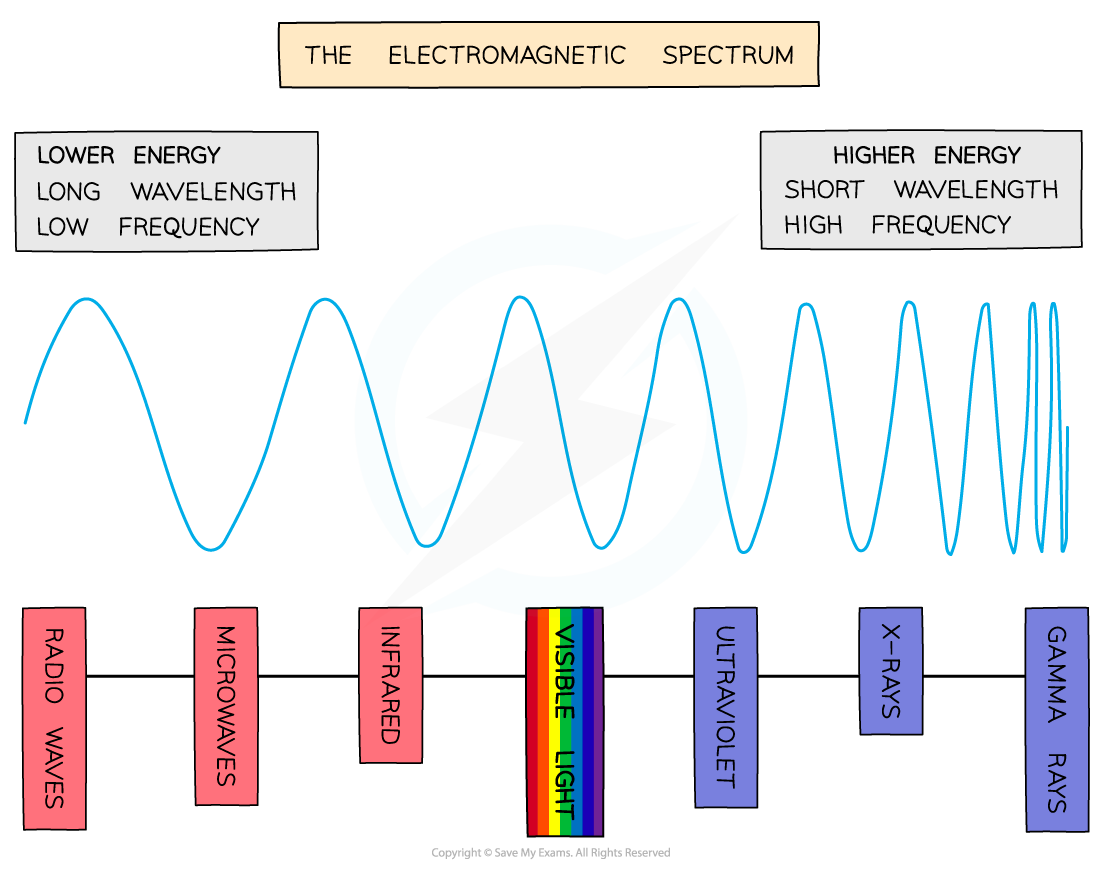Chapters
Discover the fascinating world of electromagnetic waves as we delve into their properties and behaviour. Uncover the fundamental characteristics of these waves, including wavelength and frequency, and explore their remarkable capability to traverse through a vacuum. Gain insights into the interconnectedness between the electromagnetic spectrum and the various types of waves, ranging from radio waves and microwaves to infrared, visible light, ultraviolet, X-rays, and gamma rays.

Electromagnetic Waves
We can define electromagnetic waves as:
"Transverse waves that carry (transfer) energy from source of the waves to an absorber are referred to as electromagnetic waves"
Properties of Electromagnetic Waves
- Transverse in nature: Electromagnetic waves are transverse. It means that their oscillations occur perpendicular to the direction of wave propagation.
- Travel through a vacuum: Electromagnetic waves can travel through space (vacuum) without needing a medium like air or water.
- Travel with the same speed in the vacuum: All electromagnetic waves travel at the same rate in a vacuum, known as the speed of light, which is approximately 3 × 10^8 meters per second.
- Wavelength and frequency: Electromagnetic waves have a wavelength, the distance between two consecutive wave crests or troughs, and a frequency, which is the number of complete waves passing a point per second. The wavelength and frequency are inversely proportional to each other.
- Energy transfer: Electromagnetic waves carry energy from the source to the absorber. The amount of energy a wave moves is directly proportional to its amplitude.
Electromagnetic Spectrum
The continuous spectrum of electromagnetic waves consists of seven distinct types. These types encompass a range of locks seamlessly transitioning from one to another.
To organize the electromagnetic spectrum, it is arranged systematically based on the wavelengths or frequencies of the waves. This arrangement is visually depicted in the diagram below, where the waves are ordered from the longest wavelength (corresponding to the lowest frequency) to the shortest wavelength (corresponding to the highest frequency).

The energy of radiation increases as its frequency increases. Radiation with higher energy possesses specific characteristics:
- It is highly ionizing and can remove electrons from atoms or molecules.
- It can harm cells and tissues, potentially leading to cancer development. Examples of such radiation include ultraviolet (UV), X-rays, and gamma rays.
On the other hand, radiation with lower energy has distinct advantages:
- It is helpful for communication, as it carries information over long distances.
- It poses less harm to humans and is generally safer than higher-energy radiation.
Relationship Between Electromagnetic Spectrum and Different Types of Waves
The electromagnetic spectrum encompasses a range of electromagnetic waves, each with different wavelengths and frequencies. The scope is organized from long and low frequencies to short and high wavelengths.
The electromagnetic spectrum encompasses various electromagnetic waves with distinct properties and applications. The range is organized based on the wavelengths or frequencies of the waves.
- Radio Waves: We have radio waves at one end of the spectrum. These waves have the longest wavelengths and lowest frequencies. Radio waves are commonly used for various forms of communication, such as broadcasting television and radio signals, as well as satellite transmissions.
- Microwaves: Moving further along the spectrum, we encounter microwaves. With slightly shorter wavelengths and higher frequencies than radio waves, microwaves find applications in cooking food, communication systems, and satellite communications.
- Infrared waves: Next in line are infrared waves, which have even shorter wavelengths and higher frequencies. Infrared light is utilized in electrical heaters, cookers for food preparation, short-range communication devices like remote controls, optical fibres, security systems, and thermal imaging cameras that detect heat signatures in the dark.
- Visible Light: Visible light is the spectrum segment our eyes can perceive. It consists of various colours, each corresponding to a specific wavelength. Visible light is used in photography to capture images and illumination for lighting purposes. Additionally, visible light plays a vital role in fibre optic communications, where coded pulses of light travel through glass fibres from a source to a receiver.

- Ultraviolet waves: Beyond visible light, we have ultraviolet waves. While invisible to the human eye, ultraviolet light can harm the body. Exposure to ultraviolet light in sunlight can lead to skin tanning or burning. Ultraviolet light is also employed in energy-efficient lamps that use fluorescent substances, which absorb ultraviolet light and re-emit it as visible light. Similarly, ultraviolet light is used in security features on banknotes to detect forgeries. Moreover, the bactericidal properties of ultraviolet light make it worthwhile for disinfecting water.
- X-rays: Moving towards the higher-energy end of the spectrum, we encounter X-rays. X-rays have shorter wavelengths and higher frequencies than ultraviolet waves. Due to their ability to penetrate matter, X-rays are commonly used in medical imaging to visualize the internal structures of the human body. They are absorbed by dense structures like bones, making X-ray images useful in identifying fractures. X-rays are also utilized to scan objects' internal systems and security scanners, such as those found in airports.
- Gamma rays: We find gamma rays at the highest energy end of the spectrum. Gamma rays have the shortest wavelengths and highest frequencies. Changes in the nucleus produce them.
Ionizing Radiation
Ionizing radiation refers to ultraviolet waves, X-rays, and gamma rays. These types of radiation possess enough energy to add or remove electrons from molecules, forming electrically charged ions. The process of ionization can have adverse effects on the body:
Ultraviolet waves can harm skin cells and eyes; prolonged exposure can heighten the risk of developing skin cancer.
X-rays and gamma rays, due to their high energy, can induce genetic mutations. These mutations can alter the genes and increase the likelihood of developing cancer.
It is essential to exercise caution and minimize unnecessary exposure to ionizing radiation to safeguard against potential health risks.












You are the best,, coz you have gotten content about the topics
Hello ! Glad to hear that you’ve found the content useful!